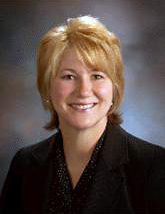Mediation figuratively and literally brings parties together. In session, the mediator actively listens and empathizes while reading the room to assess the feasibility of settlement.
So, how do we adjust in this era of social distancing? Two experienced mediators discuss their experiences.
Lisa Derr on Helping Clients with Technology
Lisa Derr of Derr & Villarreal in Beaver Dam is currently chair of the Dispute Resolution Section. A mediator since 1995, she continued her mediations through Zoom after the safe-at-home order in March 2020.
Derr said she realized that mediating by video conference is not as straightforward as in person sessions. There are additional considerations.

Lisa Derr is chair of the Dispute Resolution Section. She has been a mediator since 1995.
First, video mediation conferences must be voluntary and accessible on a secure platform. You need to confirm their willingness to use technology that is free and secure. Derr also learned that clients have significantly different levels of comfort with technology. Explaining how it works takes much longer with some people.
To ensure some comfort with the Zoom platform, Derr and her partner schedule practice video sessions at no charge. Clients practice getting on, sharing a screen, as well as going in and out of a Zoom waiting room to caucus. It is easier to learn when people are less stressed. Clients can try out audio and video controls without worrying about what they are going to say in the actual mediation.
Second, accessibility can refer to lack of hardware as well as client’s comfort level with software. Initially, some clients could not even access a computer for sessions. Clients insisted that their cellphone would be “fine” but after a few initial attempts, Derr determined that using a cellphone was not feasible to review documents during a session.
Instead, when a client did not have access to a computer, Derr & Villarreal set up an additional computer in a smaller conference room which the client could use for both practice and actual sessions. The other party appears on Zoom from their home. In this situation, because of COVID-19 as well as to ensure the perception of neutrality, the mediator also uses Zoom from a different conference room.
Derr emphasized that it is important if one party is disconnected not to treat it as a quick caucus with the other. Instead, stop the session, put the remaining party in a waiting room and assist reconnecting the first one. Most clients do not feel that an unscheduled caucus is fair.
Normally, Derr said, she would not immediately provide the Agreement to Mediate before the session. But since people have already had a practice Zoom as well as individual background calls, it was easier to send the Agreement to Mediate the day before the session to allow clients to print it if they preferred reviewing that document on paper. At the first session, they review the terms and make sure all questions are answered.
Derr sends the Agreement to Mediate to be signed during the Zoom meeting through Adobe Acrobat for e-signing. While on Zoom, the mediator and parties verify that it was received, ask any final questions, and sign the document. This also helps clients get comfortable with the signing process long before they sign any substantive agreement between them.
The last factor is confidentiality. While all mediators reference this, Derr & Villarreal’s policy is to specify that the parties agree they will not record audio, video, or take screen shots. They also ask clients confirm that they will not have anyone else in the room unless that person was included in the mediation. It is also a good idea to ensure in the master software settings that parties cannot record the session. While Derr is looking forward to returning to in-person meetings, she feels that video sessions will now always be another alternative for mediators long after this crisis is over.
Judge Charles Kahn on Video Conferencing
Judge Charles Kahn (retired) of A Neutral View, LLC, is a former section board member with a thriving mediation practice in downtown Milwaukee. During the ongoing coronavirus pandemic, he is also turning to technology. “It’s so easy now to communicate by video, so it just makes sense,” he said.

Retired Judge Charles Kahn heads a mediation practice in downtown Milwaukee.
Judge Kahn is known for his active listening skills and empathy. A key component to his success, he says, is getting to know the parties ahead of the mediation by meeting in person, and by giving them the floor to make an initial presentation without the time pressure of the mediation day.
Judge Kahn notes that while an in-person mediation is ideal, video conferencing is far superior to a voice call. It allows the mediator to take a measure of the parties, and vice versa. It effectively builds the rapport and trust needed for the parties to ultimately take a leap and resolve a case they thought was hopeless.
Judge Kahn notes that even an application as basic as iPhone’s Facetime now allows for multiparty video conferencing. He had already been using this technology for those initial meetings when the parties were more than 60 miles away, to avoid the need to travel twice.
Conclusion: Technology Can Boost Mediation
As we navigate the unprecedented changes in day to day life in the days ahead, we are thankful for technological advances that make these days easier and more tolerable. We can also implement them in a manner that enhances the mediation experience for the clients on a secure platform while maintaining neutrality and confidentiality.
This article was originally published on the State Bar of Wisconsin’s Dispute Resolution Blog. Visit the State Bar sections or the Dispute Resolution Section web pages to learn more about the benefits of section membership.
